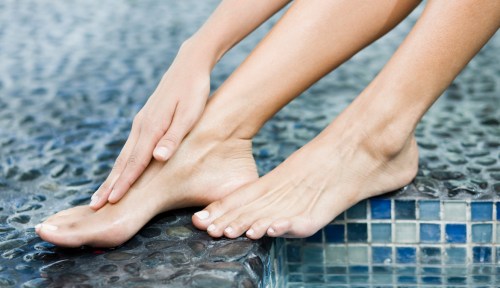There’s nothing I love more than getting a pedicure. But while a salon massage chair and a few coats of pretty polish are all I need to feel relaxed, when I decided I wanted something that really targeted my foot health, I turned to Suzanne Levine, DPM, an aesthetic podiatrist and podiatric foot surgeon, who offers what she calls ‘foot facials.’
Experts in This Article
aesthetic podiatrist and podiatric foot surgeon
“Foot Facial terminology is something that I developed over the years because I always thought [about] how we spend so much time on our face and neglect our poor feet,” says Dr. Levine. “We have fissures back at the heel, we’ve got these gross-looking nails, and nobody ever pays any attention to their feet. And the majority of the time, by the time patients [come to our office], their feet have fungus, thick nails, thick calluses, or cuts in their feet.”
To remedy all of these issues, she decided she would treat people’s feet in the same way that estheticians treat their faces. “I decided to call it foot facial and I put a procedure together with ingredients similar to what you use on your face—glycolic acids, alpha hydroxy acids, peels, and electrical stimulation lasers,” she says. It’s honestly too sophisticated to be considered a pedicure: It’s a high-level treatment that will leave your feet refreshed and baby soft.
The benefits of a foot facial
While taking care of your feet may seem largely cosmetic (after all, no one likes looking at gnarly toenails), Dr. Levine says it can impact your entire body.
“If you have a lot of callouses, that’s telling you that you have a biomechanical issue,” she says. “It means your foot isn’t hitting the ground properly, and you can end up with knee problems, hip problems, and back problems.” And if you leave the callouses untreated, it will just make these issues worse over time.
The acids Dr. Levine uses in her foot facials are much more potent than the ones typically used on the face, because the skin on your feet is far thicker than anywhere else in the body. Not only do these strong acids deliver immediate results, but they also help Dr. Levine’s treatments last far longer than traditional pedicures. Plus, because Dr. Levine is a physician, she’s able to address issues that a salon or medspa pedicure can’t (like those thick calluses and fungi she mentioned).
This Parisian Skincare Brand Is Launching in the United States for the First Time—Here’s What a Derm Wants You to Know

We’re Calling It: Cleansing Balms Are the Face Wash of the Future—Here Are 3 to Add to Your Cart

This Is the One Product That Scarlett Johansson Always Keeps in Her Purse and on Her Bedside Table

A few tell-tale signs that your standard pedis aren’t doing enough? Your feet feel good for a few days before discomfort returns, you experience calluses that come back often, you bleed during callus removals, or you have thick or discolored nails. If any of these issues sound familiar, it’s time to see a podiatrist for a more intensive treatment regimen.
What it’s like getting a foot facial
On the day of my foot facial, I took a trip to Dr. Levine’s office, Millennium Podiatry, in Manhattan, where the 45-minute treatment took place on a typical doctor’s office bed (there’s no massage chair, foot bath, or polish change). Dr. Levine started by taking off my nail polish and cleaning my feet, and explained that it’s important for her to see a patient’s nails so that she can look for melanomas (aka skin cancer) and fungus.
Next, she carefully removed blisters and callouses off my feet with a scalpel.
“In order to use a blade in the state of New York, you have to be a physician,” says Dr. Levine, noting that “Unfortunately, a lot of medical spas use the blades and it’s dangerous.” She explains that if you have a bad skin condition paired with diabetes, a peripheral vascular disease, or other comorbidities, incorrectly using a blade can be dangerous, so it’s best to leave the more serious skin-scraping to a podiatrist.
Once my feet had been properly sloughed, she applied a foot mask made with clay and salicylic acid, two ingredients that help detoxify pores and melt off any remaining dead skin cells. Dr. Levine used two microcurrent wands to help the ingredients penetrate deeper, which felt cold and tingly (and were such a treat for my achy feet).
After washing off the mask, Dr. Levine applied a foot cream of her own creation (which you can buy in her office or via phone). It’s made with lactic acid, which gently exfoliates the skin; vitamin C for brightening and antioxidant benefits; niacinamide for calming and redness reduction; and aloe vera and shea butter for hydration and moisture. Once again, she used the microcurrent wands to help the product soak in. This time, the stimulation felt slightly more intense—it stung a little in the spots where my blisters had been removed, but it wasn’t too bad. To finish things off, she massaged the rest of the lotion into my skin.
I walked out of the appointment feeling relaxed, cared for, and with a better understanding of my feet. The most important lesson I learned? If your feet are bothering you or giving you repetitive issues, it’s probably time to take your pedicure to the next level with a trip to the podiatrist’s office.
Watch out senior beauty editor tackle the ultimate at-home pedicure:
Want even more beauty intel from our editors? Follow our Fineprint Instagram account for must-know tips and tricks.
Sign Up for Our Daily Newsletter
Get all the latest in wellness, trends, food, fitness, beauty, and more delivered right to your inbox.
Got it, you've been added to our email list.








